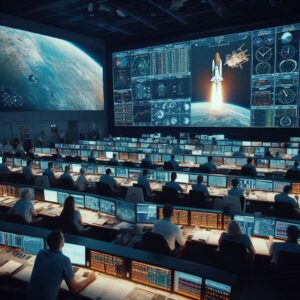Introduction
In a dramatic turn of events, NASA and SpaceX have postponed their planned mission to rescue astronauts currently stranded in space. The delay has raised concerns about the well-being of the astronauts and the challenges of space travel. While NASA and SpaceX are working tirelessly to resolve the situation, questions arise about what led to this emergency and how the space agencies plan to bring the crew back safely. This incident highlights the complexities of modern space exploration and the risks that astronauts face in their missions beyond Earth.
Why Are the Astronauts Trapped in Space?
Astronauts getting trapped in space is not a common occurrence, but when it does happen, it can be a nerve-wracking situation. The current crisis stems from technical failures aboard their spacecraft, which has rendered their return journey impossible. Some sources suggest that a malfunction in the propulsion system or a critical software glitch may have compromised the vehicle’s ability to safely re-enter Earth’s atmosphere.
Additionally, the growing problem of space debris has been a contributing factor. NASA and SpaceX have both raised concerns about the increasing amount of debris in Earth’s orbit, which poses a risk to operational spacecraft. A possible collision with space junk may have damaged crucial components of the rescue vehicle, forcing the postponement of the mission. (NASA’s report on space debris)
NASA and SpaceX’s Rescue Mission Plan
Initially, SpaceX and NASA had a well-structured rescue plan in place. The mission involved launching a modified Crew Dragon capsule, designed to dock with the stranded spacecraft and safely retrieve the astronauts. This rescue mission was expected to be executed using Falcon 9, a highly reliable rocket known for its success in launching crewed and uncrewed missions to the International Space Station (ISS).
The plan was to launch from Kennedy Space Center and conduct an automated docking procedure with the stranded astronauts’ spacecraft. Once the crew was secured, the vehicle would re-enter Earth’s atmosphere and splash down in the Atlantic Ocean, where NASA and SpaceX recovery teams would retrieve them.
Why Was the Mission Postponed?
NASA and SpaceX made the difficult decision to postpone the mission due to a combination of technical and safety concerns. Some of the key reasons for this delay include:
1. Technical Challenges
SpaceX engineers discovered a fuel leak in the Crew Dragon capsule, which could pose a significant risk during re-entry. Addressing this issue is critical before proceeding with the mission.
2. Unfavorable Weather Conditions
SpaceX’s Falcon 9 launch window depends heavily on weather conditions. High winds or storms in the launch or landing zones can jeopardize the mission’s success. The current adverse weather over the Atlantic Ocean made it unsafe for a splashdown recovery operation.
3. Communication Issues
NASA has also reported intermittent communication problems with the stranded astronauts, making it difficult to coordinate the rescue. SpaceX and NASA engineers are working on stabilizing contact before proceeding with the mission.
(SpaceX’s official mission updates)
What This Means for the Astronauts in Space
For now, the stranded astronauts remain in a low-Earth orbit, awaiting a green signal for the rescue mission. Fortunately, they are aboard a functional spacecraft with access to sufficient oxygen, food, and water supplies. However, prolonged delays could lead to challenges such as:
- Mental and Physical Strain: Astronauts undergo extensive training for emergencies, but being trapped in space longer than expected can increase stress levels.
- Declining Spacecraft Condition: Systems such as life support and power supply are designed for specific mission durations. A prolonged delay may put additional stress on these systems.
- Orbital Decay Risks: If the spacecraft’s altitude isn’t properly maintained, gravitational forces could pull it into an uncontrolled descent.
Alternative Solutions and Emergency Protocols
If SpaceX and NASA cannot proceed with their primary rescue plan soon, alternative measures may be considered:
1. Using the International Space Station (ISS) as a Safe Haven
If the astronauts are close enough, they could potentially dock with the ISS and stay there temporarily. The ISS is equipped with necessary resources and emergency escape vehicles like the Soyuz spacecraft.
2. Utilizing a Russian Soyuz Capsule
Russia’s Roscosmos has successfully conducted emergency space rescues in the past. If necessary, NASA could collaborate with Roscosmos to deploy a Soyuz spacecraft to bring back the astronauts. (Roscosmos Official Site)
3. Expediting the Artemis Program
With the increasing involvement of commercial space programs, NASA and SpaceX may look into the feasibility of integrating rescue missions with the upcoming Artemis lunar program.
Public and Expert Reactions
The delay in the rescue mission has sparked widespread discussions among space enthusiasts, scientists, and the general public.
- Space Experts: Some experts believe that NASA and SpaceX made the right decision by prioritizing safety. Rushing a mission under uncertain conditions could lead to greater risks.
- Space Enthusiasts: Many followers of SpaceX and space exploration have taken to social media to express concerns about astronaut safety. Some have questioned whether NASA and SpaceX had an effective contingency plan in place.
- Critics: There has been criticism regarding the over-reliance on commercial space companies like SpaceX for crucial missions. Some argue that government space agencies should have backup rescue options available at all times.
(Read what experts say on Space.com)
Future Implications for Space Missions
The postponement of the SpaceX rescue mission raises several critical questions about future space missions:
- Stronger Backup Plans: NASA and SpaceX may need to develop better contingency strategies for astronaut rescue missions.
- Spacecraft Reliability: This incident highlights the need for more reliable and redundant spacecraft systems to minimize failures.
- International Collaboration: The situation may prompt increased international cooperation in space exploration, ensuring that multiple agencies have rescue capabilities.
- Advancements in AI & Automation: Future missions may benefit from AI-driven self-repairing spacecraft that can handle technical failures autonomously.
Conclusion
The delay in NASA and SpaceX’s rescue mission underscores the challenges and risks of space exploration. While safety concerns warranted the postponement, the stranded astronauts remain a top priority for both agencies. As the world watches closely, space agencies are working around the clock to ensure a safe and timely rescue.
This event serves as a reminder that despite rapid advancements in space technology, space travel remains a highly unpredictable endeavor. The lessons learned from this situation will undoubtedly shape the future of human spaceflight, paving the way for safer and more efficient missions beyond Earth.
For real-time updates on the situation, follow NASA’s official website and SpaceX’s mission updates.





